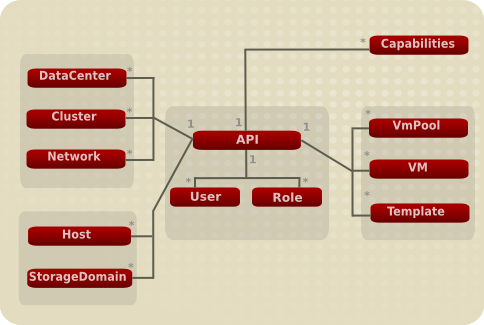A user begins interacting with the API through a GET request on the entry point URI consisting of a {host} and {base}.
GET {base} HTTP/1.1
Host: {host}
HTTP/1.1 200 OK
Link: <http://{host}/{base}/hosts>; rel=hosts, <http://{host}/{base}/vms>; rel=vms
Content-Type: application/xml
<api>
<link rel="hosts" href="{base}/hosts"/>
<link rel="vms" href="{base}/vms"/>
...
<special_objects>
<link rel="templates/blank" href="..."/>
<link rel="tags/root" href="..."/>
</special_objects>
<summary>
<vms>
<total>10</total>
<active>3</active>
</vms>
<hosts>
<total>2</total>
<active>2</active>
</hosts>
<users>
<total>8</total>
<active>2</active>
</users>
<storage_domains>
<total>2</total>
<active>2</active>
</storage_domains>
</summary>
</api>
For simplicity, all other examples omit the Host request header and assume {base} is the default /rhevm-api. This base path will differ depending on your implementation.
Access to the Entry Point provides the Link header [] , link elements and URIs for all of the resource collections exposed by the API. Each collection uses a relation type to identify the URI a client needs. The following relation types are available:
All URIs shown in example responses are purely illustrative. The format of all URIs returned by the server is opaque. Clients must navigate to any specific resources through the entry point URI and use the relationship types to access the URIs.
The server may choose to include absolute URIs or absolute paths [] in the link element href attribute, so clients should be prepared to handle either form. Link headers will only contain absolute URIs.
In addition to the literal URIs described above, the Link header also contains a set of URI templates [] , which describe the form of URI used for sending search queries to the collections. Each URI template is identified by a relation type, named according to the convention "collection/search".
The purpose of the URI template is to accept a search expression using the natural HTTP pattern of a query parameter. The client does not require prior knowledge of the URI structure. Thus clients should treat these templates as being opaque and instantiate them via a URI template library such as the Google Code
uri-templates Python package or the Apache Abdera
support for Java templates.
The following relation types are associated with query URI templates:


